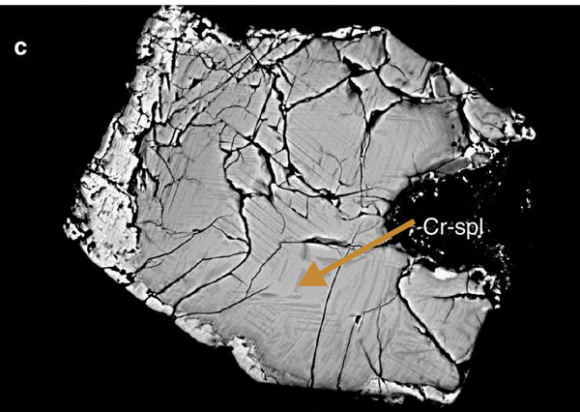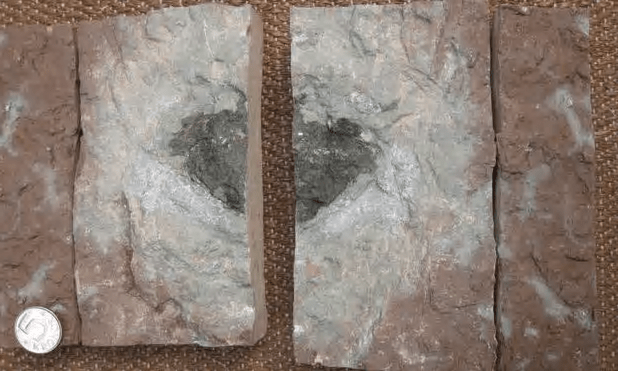470 million years ago, somewhere in our Solar System, there was an enormous collision between two asteroids. We know this because of the rain of meteorites that struck Earth at that time. But inside that rain of meteorites, which were all of the same type, there is a mystery: an oddball, different from the rest. And that oddball could tell us something about how rocks from space can change ecosystems, and allow species to thrive.
This oddball meteorite has a name: Osterplana 65. It’s a fossilized meteorite, and it was found in a limestone quarry in Sweden. Osterplana 65 fell to Earth some 470 mya, during the Ordovician period, and sank to the bottom of the ocean. There, it became sequestered in a bed of limestone, itself created by the sea-life of the time.
The Ordovician period is marked by a couple thing: a flourishing of life similar to the Cambrian period that preceded it, and a shower of meteors called the Ordovician meteor event. There is ample evidence of the Ordovician meteor event in the form of meteorites, and they all conform to similar chemistry and structure. So it’s long been understood that they all came from the same parent body.
The collision that caused this rain of meteorites had to have two components, two parent bodies, and Osterplana 65 is evidence that one of these parent bodies was different. In fact, Ost 65 represents a so far unknown type of meteorite.

The study that reported this finding was published in Nature on June 14 2016. As the text of the study says, “Although single random meteorites are possible, one has to consider that Öst 65 represents on the order of one per cent of the meteorites that have been found on the mid-Ordovician sea floor. “It goes on to say, “…Öst 65 may represent one of the dominant types of meteorites arriving on Earth 470 Myr ago.”
The discovery of a type of meteorite falling on Earth 470 mya, and no longer falling in our times, is important for a couple reasons. The asteroid that produced it is probably no longer around, and there is no other source for meteorites like Ost 65 today.
The fossil record of a type of meteorite no longer in existence may help us unravel the story of our Solar System. The asteroid belt itself is an ongoing evolution of collision and destruction. It seems reasonable that some types of asteroids that were present in the earlier Solar System are no longer present, and Ost 65 provides evidence that that is true, in at least one case.
Ost 65 shows us that the diversity in the population of meteorites was greater in the past than it is today. And Ost 65 only takes us back 470 mya. Was the population even more diverse even longer ago?
The Earth is largely a conglomeration of space rocks, and we know that there are no remnants of these Earthly building blocks in our collections of meteorites today. What Ost 65 helps prove is that the nature of space rock has changed over time, and the types of rock that came together to form Earth are no longer present in space.
Ost 65 was found in amongst about 100 other meteorites, which were all of the same type. It was found in the garbage dump part of the quarry. It’s presence is a blemish on the floor tiles that are cut at the quarry. Study co-author Birgen Schmitz told the BBC in an interview that “It used to be that they threw away the floor tiles that had ugly black dots in them. The very first fossil meteorite we found was in one of their dumps.”
According to Schmitz, he and his colleagues have asked the quarry to keep an eye out for these types of defects in rocks, in case more of them are fossilized meteorites.
Finding more fossilized meteorites could help answer another question that goes along with the discovery of Ost 65. Did the types and amounts of space rock falling to Earth at different times help shape the evolution of life on Earth? If Ost 65 was a dominant type of meteorite falling to Earth 470 mya, what effect did it have? There appear to be a confounding number of variables that have to be aligned in order for life to appear and flourish. A shower of minerals from space at the right time could very well be one of them.
Whether that question ever gets answered is anybody’s guess at this point. But Ost 65 does tell us one thing for certain. As the text of the study says, “Apparently there is potential to reconstruct important aspects of solar-system history by looking down in Earth’s sediments, in addition to looking up at the skies.”


Way cool! This article made me think about all the meteor, asteroid and comet fragments on the moon and how glad I am that the asteroid return mission has been put on indefinite hold and we are refocusing our energies in a return to the moon! WHAT early fragments will we find there?
Vacuum kept 6 billions year old meteor samples anyone?
This article is so full of holes one wonders how to start. For example, how is this rock different than the rest? Why are they assuming no more exist? Why are they assuming the rock represents the collision of the asteroids at that time:? It could have been a billion years before. Those shock lines show a collision, how do they rule out the collision with earths air which is pretty solid if the rock is traveling at a very high velocity? How many assumptions are going into to all the claims made? I guess you have to read the actual paper to see if the data even starts to support the claims in this article.
I agree, there is much that is confusing about this article. How does this meteorite differ from all the others? And why is it justified to draw such grandiose conclusions from a sample size of just one rock?
Ahhhh… anonymous downvote spamming. How tediously predictable and petty.
Who’s anonymous? Try reading the paper first, is all I’m saying.
The paper’s abstract, from the link to the entire paper which Evan provided in the story above:
“From mid-Ordovician ~470?Myr-old limestone >100 fossil L-chondritic meteorites have been recovered, representing the markedly enhanced flux of meteorites to Earth following the breakup of the L-chondrite parent body. Recently one anomalous meteorite, Österplana 065 (Öst 65), was found in the same beds that yield L chondrites. The cosmic-ray exposure age of Öst 65 shows that it may be a fragment of the impactor that broke up the L-chondrite parent body. Here we show that in a chromium versus oxygen-isotope plot Öst 65 falls outside all fields encompassing the known meteorite types. This may be the first documented example of an ‘extinct’ meteorite, that is, a meteorite type that does not fall on Earth today because its parent body has been consumed by collisions. The meteorites found on Earth today apparently do not give a full representation of the kind of bodies in the asteroid belt ~500?Myr ago.” (emphasis mine)
It might well be a “guess the dinosaur by the fossil fragment” kind of paper, but I plan to read the rest of it (available at the same link) before feeling free to poke holes &/or ask questions. The article might have done more to delve into some of the specifics, but it did provide a link to the study itself, which is less & less common these days in the average science-related press release.
After a quick reading, this is the sum total of what the paper claims:
1)An unknown meteorite was found inside a bed of many other meteorites of known classification, 2)the object has no compositional commonality with those that fell around it, and 3)it has no commonality with any other known meteorite. These findings suggest A)that no parent body currently exists to produce such objects today, and so B)we might be able to use the presence/absence of such objects to better understand the formation & evolution of our solar system.
The guess-timate from the paper (quoted in the UT article) of Öst 65 possibly representing ~1% of all meteorites in that era is shady but not unreasonable (under the “0, 1, infinity” rule), as it’s based on the discovery of one completely unique odd-ball amongst >100 others found in the same relatively small sample from a single era. Using that guess as a rough guide leads to the following conclusion found in the Discussion section of the paper:
“Although we cannot rule out that a meteorite similar to Öst 65 may eventually be found among meteorites falling on Earth today, we can be quite certain that the Öst 65 type does not represent one per cent of the 52,600 classified recent meteorites. At the most there could be a few overlooked specimens.” (emphasis mine)
” What Ost 65 helps prove is that the nature of space rock has changed over time…”
~ So does Tangerine Dream. :chuckle:
Oh c’mon people, this article is very typical of most articles on anything to do with science. There is a whole lot of information and a whole lot of speculation and a whole lot of opinion, but very little substance and nothing that comes close to facts or even an opinion from even one scientist working on this particular event. This is how its done and will always be done, and why the field of evolution is such a mess. The fact that out of the billions of fossils that we have and not one transitional form can be found among them, yet all we read is that the fossil evidence alone proves evolution, what a joke. Even Darwin said if we cannot find transitional forms in the fossil record, then his theory has been proven wrong.